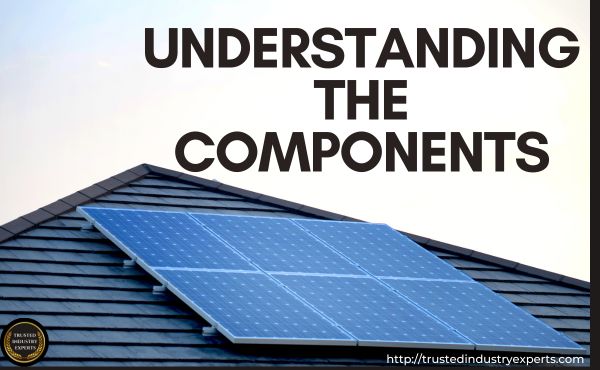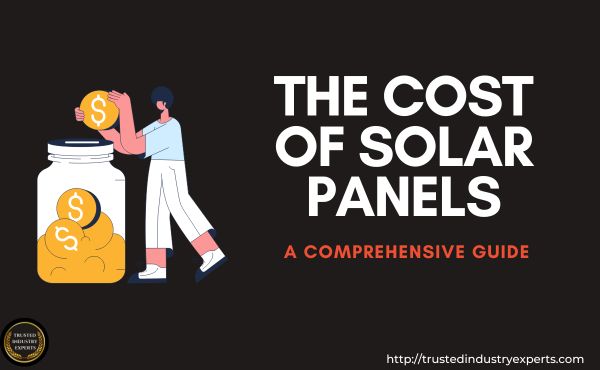The Cost of Solar Panels
Welcome to our comprehensive guide on the cost of solar panels. At Trusted Industry Experts, we believe in providing you with valuable insights to help you make informed decisions about your solar panel installation. In this guide, we will delve into various factors that influence and determine solar panel cost, including equipment expenses, installation costs, and potential savings over time. By the end, you’ll have a clear understanding of the investment required for a solar panel system and its long-term benefits. Let’s get started!
Understanding the Components

The national average cost for a residential solar system installation is around $18,000 for a 5-kilowatt hour (kWh) system. This will vary depending on your location and the climate in your area. In addition to the initial expense, you may be eligible for solar rebates or incentives from both the federal government and your local utility provider. Additionally, many states offer credit programs that allow you to receive up to 30% of your total solar panels cost installed back in the form of tax credits. With these cost savings, it’s easy to see why an increasing number of homeowners are choosing to make the switch to a solar-powered home.
Before we delve into the cost considerations, let’s take a moment to understand the components that make up a solar panel system:
Solar Panels:
These are the core components that convert sunlight into electricity. When considering money spent on solar panels, the number of panels needed will depend on several factors such as the size of your roof, the amount of sunlight exposure and energy needs. Generally speaking, a 5 kWh system requires around 20-30 solar panels to generate enough energy to power a home. The total cost of a solar panel system includes both the cost of purchasing and installing the solar panels, as well as any additional equipment such as mounting systems, wiring, batteries and inverters. On average, it can cost upwards of $20,000 to completely install a 5 kWh system.
In addition to providing clean energy for your home, many solar panels installed today can also allow you to sell excess solar energy back to the grid or even use it to power electric vehicles. Solar panel systems are designed to generate power when sunlight is available and store excess energy for later use during times when there is no light or when demand for electricity is high. As an added bonus, solar power systems require minimal maintenance once installed. With proper care and regular professional inspections, your system should be able to provide clean energy for decades without any issues.
Inverters:
These devices convert the direct current (DC) electricity produced by solar panels into alternating current (AC) electricity for use in your home.
The upfront cost of a residential solar system can be daunting, however it’s important to remember that the money spent on solar panels is an investment in your long-term energy savings. Depending on how many panels are needed for your roof size and energy needs, you can expect to pay around $20,000 for a 5 kWh system. Fortunately, there are several ways to offset this expense such as utilizing solar rebates and incentives from both the federal government and local utility providers. Additionally, many states offer credit programs that allow homeowners to receive up to 30% of their total cost of solar panel installation back in the form of tax credits.
Solar technology is constantly progressing making it easier for homeowners to generate more energy with fewer panels. This means that the solar power system you install today may be able to generate more than you were expecting when taking into account the available sunlight exposure and other factors. Solar panels generate electricity when exposed to light, storing excess energy for later use during times when demand is high or not enough light is available. With proper care and regular inspections, your system should provide power efficiently throughout its lifespan with minimal maintenance required over time.
Racking and Mounting:
These structural elements securely attach the solar panels to your roof or ground, ensuring their stability.
In determining the cost of a solar panel system, it is important to take into account not only the upfront costs but also any long-term savings or incentives. Many homeowners opt for financing options such as solar loans or power purchase agreements that allow them to pay for their residential solar systems over time with no upfront cost. In addition, government rebates and tax credits can help offset the cost of installation, making it more accessible to those who may not have the resources to cover all expenses at once.
As an added bonus, installing solar panels can also save you money over time. On average, customers see between 10-30% savings on their annual electricity bills after transitioning to a solar-powered home. This means that although you may incur some initial expense when purchasing and installing solar panels, the long-term benefits can be significant. Additionally, many utility providers offer net metering programs that give customers credit for excess energy generated by their system during times when demand is low. This helps ensure that customers get the most out of their investment in a residential solar panel system and are able to maximize their energy savings over time.
Electrical Wiring:
This includes the wiring that connects the solar panels to the inverter and your home’s electrical system.
In addition to financing options such as loans and power purchase agreements, solar leases are also becoming increasingly popular among homeowners. Solar leases allow you to lease a solar panel system from a qualified solar installer with no money down and make monthly payments over the course of several years. This is a great option for those who don’t have the upfront cost to invest in a residential system but still want to benefit from lower energy bills and other long-term savings.
The Solar Energy Industries Association (SEIA) estimates that the average cost of leasing a 5kW residential system is around $50 per month depending on your location, making it an attractive option for those who don’t have an immediate access to capital funds. Furthermore, if you decide to purchase your solar panels outright, you may be eligible for the federal Solar Investment Tax Credit (ITC), which can offset up to 30% of your total expenses.
When considering how many solar panels are needed for an installation, it is mostly determined by the size of your roof and energy needs. Generally speaking, a 5kW system requires about 20-30 panels depending on the amount of sunlight exposure and other factors. By having an accurate estimate of both equipment costs and installation fees prior to committing to any contractor, you can ensure that you are getting the most out of your investment in clean energy solutions.
Monitoring System:
This optional component allows you to track the performance of your solar panel system and monitor energy production.
When transitioning to a solar-powered home, it is important to ensure that you are working with a trusted and knowledgeable solar installation company. Polycrystalline solar panels are often the most cost-effective option when it comes to residential installations, as they generate more power per panel than mono or thin film models. Additionally, many households choose to take advantage of PPAs which allow them to pay for their solar energy system over time without any upfront costs. With a PPA, homeowners can reap the benefits of reduced electricity bills and environmental friendliness of solar energy without having to worry about financing the initial expenses.
Solar panels are designed to save you money in the long run by generating clean electricity that can be used for your home or sold back to the grid for profit. On average, customers see between 10-30% savings on their annual electric bills after transitioning to a solar-powered home. In fact, in some cases the savings from switching to solar are so significant that they can completely offset the cost of purchasing and installing your system over time. This means that while an upfront investment is required in order to install a residential system, you can expect impressive returns over time as your solar panels help power your home efficiently and reliably with minimal maintenance required on your part.
Factors Affecting Solar Panel Costs
The solar incentives offers an additional incentive for those looking to install solar panels in their homes. If you purchase your residential solar panels outright, you can receive up to 30% of the total cost of installation back in the form of a tax credit. This can be a great way to offset some of the initial expenses associated with solar panel installation, particularly if you don’t have access to upfront capital funds.

Additionally, many utility providers offer net metering programs that give customers credit for excess energy generated by their system during times when demand is low. This helps ensure that customers get more out of their investment and are able to maximize their energy savings over time. Power purchase agreement (PPAs) are also becoming increasingly popular among homeowners as they provide an alternative option for financing solar panel systems without any money down. With a PPA, homeowners can pay for their systems over time while enjoying lower electricity bills and other long-term savings associated with using clean energy solutions.
Overall, investing in a residential solar panels is a great way to reduce your monthly electricity bill and help protect the environment. The initial cost may seem daunting at first, however there are several ways to offset it such as utilizing government rebates and federal solar tax credit or opting for power purchase agreement(PPAs). Additionally, many states offer credit programs that allow homeowners to receive up to 30% of their total average cost of solar panel installation back in the form of tax credits.
Now, let’s explore the various factors that influence the solar system costs:
1. System Size
The size of the solar panel system you require will significantly impact the overall cost. Larger systems generate more electricity but also come with a higher upfront investment. Factors to consider when determining the system size include your average energy consumption, available roof space or land area, and future energy needs.
2. Quality of Solar Panels
Solar panel prices can vary based on their quality, efficiency, and warranty. High-quality panels may have a higher initial cost but can offer better performance and durability, leading to greater long-term savings.
3. Installation Costs
The installation process involves several factors that can influence the overall cost:
Labor Costs:
Experienced and certified installers may charge higher rates, but their expertise ensures a safe and efficient installation.
Permitting and Inspection:
Local regulations may require permits and inspections, which can incur additional fees.
Thin film solar panels are a type of photovoltaic cells that are typically less efficient than conventional monocrystalline solar panels. This can result in lower installation costs as fewer panels are needed to generate the same amount of electricity. However, thin film solar panels may also require more maintenance over time and have shorter lifespans compared to monocrystalline solar panels. When selecting a solar company for your residential installation, ensure that they offer warranties and guarantees on product quality to help protect your investment.
In addition to utilizing incentives and rebates from the government and utility providers, financing options such as solar loans can be another great way to offset the cost of purchasing and installing solar panels for your home. Solar loans allow homeowners to pay for their system over time with no money down and fixed interest rates, making them an attractive option for those who don’t have the resources to cover all expenses at once.
The total cost of a residential solar panel installation costs will vary depending on several factors such as system size, available sunlight exposure, equipment quality, labor costs, permitting fees, and other factors. Prior to committing to any contractor, it is important to get an accurate estimate of both equipment costs and installation fees so you can make sure that you are getting the most out of your investment in clean energy solutions.
Roof Complexity:
If your roof has a complex design, such as multiple levels or angles, the installation may require more time and effort, impacting the installation cost.
4. Location
Your geographic location plays a role in solar panel costs due to variations in sunlight intensity, climate, and local incentives. Areas with higher levels of sunlight generally yield better energy production, which can offset the initial investment over time.
5. Financial Incentives
Government incentives, such as federal solar tax credit, rebates, and grants, can significantly reduce the overall cost of installing solar panels. It’s essential to research and understand the incentives available in your area to maximize your savings.
Calculating the Cost
Now, let’s dive into estimating the cost of a solar panel system. Please note that this is a general overview, and actual costs may vary depending on your specific requirements and location.
When it comes to solar panels cost, the solar panel system upfront investment can be significant, however there are several ways to offset it such as utilizing government rebates and incentives from both the federal government and local utility providers. Additionally, many states offer credit programs that allow homeowners to receive up to 30% of their total cost of solar panel installation back in the form of tax credits. Solar leases are also becoming increasingly popular among homeowners, allowing them to lease a solar panel system with no money down and make monthly payments over the course of several years. Furthermore, if you decide to purchase your solar panels outright, you may be eligible for the federal Solar Investment Tax Credit (ITC), which can offset up to 30% of your total expenses.
When looking for a reliable solar for your residential needs, make sure to research their experience and certifications as well as any special offers or financing options they may have available. Most reputable solar companies will provide detailed estimates for both equipment costs and installation fees prior to committing to any contractor. It’s also important to make sure you understand all terms associated with any solar lease agreement before signing on the dotted line. With a little bit of research and due diligence, you can ensure that you find a trustworthy company who will help you get the most out of your investment in clean energy solutions.
System Size:
Determine the appropriate system size based on your energy needs and available space. For example, a typical residential system may range from 3 kW to 10 kW.
Installing solar panels can provide significant long-term savings, with the average customer seeing between 10-30% reductions in their annual electricity bills. With money solar panels save from reduced energy costs, many homeowners opt for financing options such as solar loans or power purchase agreements that allow them to pay for their residential solar system over time with no upfront cost. In addition, government rebates and tax credits can help offset the cost of installation, making it more accessible to those who may not have the resources to cover all expenses at once.
When it comes to installing solar panels, it is important to work with a qualified and knowledgeable solar installers. Experienced installers will be able to provide detailed estimates for both equipment costs and installation fees prior to committing to any contractor. It’s also important to make sure you understand all terms associated with any financing agreement before signing on the dotted line. With the right information and research, you can ensure that you are working with an experienced Solar Installers who will ensure your system is installed correctly and safely while helping you get the most out of your investment in clean energy solutions.
Cost per Watt:
Solar panel costs are often measured in dollars per watt ($/W). To estimate the cost, multiply the system size (in kilowatts) by the average cost per watt in your area. This will give you a rough idea of the equipment expenses.
Installation Costs:
Installing a solar panel system is a brilliant way to reduce your dependency on traditional forms of energy. However, before you get too excited about the environmental benefits and potential savings, it’s important to consider the installation costs. This can include labor costs, permits, and inspections. But don’t let the thought of these additional expenses bring you down
In nutshell, upgrading your main electrical panel is a crucial step in ensuring the smooth functioning and safety of your solar panel system. Many homeowners are making the switch to solar energy in order to save money and reduce their carbon footprint, but without proper electrical upgrades, the investment may not be fully optimized. A panel upgrade involves making sure that your electrical system can handle the increased power requirements of solar energy, which is necessary to ensure its effectiveness and safety. By adding circuit breakers, wires and other components, you can increase the amount of power your home can handle, protecting your investment and avoiding potential safety hazards. With a proper electric panel upgrade, you can experience the full benefits of your solar panel system, saving money on energy bills and contributing to a cleaner environment. Don’t let an inadequate electrical panel limit the potential of your solar investment – upgrade today.




